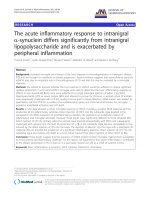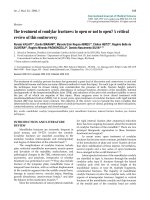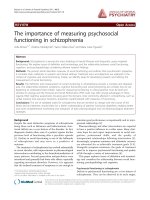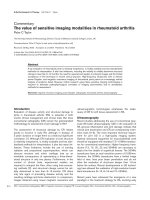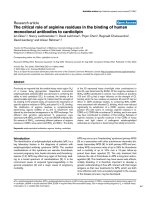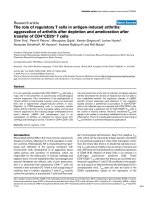Báo cáo y học: "The Systemic Inflammatory Response Syndrome (SIRS) in acutely hospitalised medical patients: a cohort study"
Bạn đang xem bản rút gọn của tài liệu. Xem và tải ngay bản đầy đủ của tài liệu tại đây (448.05 KB, 6 trang )
BioMed Central
Page 1 of 6
(page number not for citation purposes)
Scandinavian Journal of Trauma,
Resuscitation and Emergency Medicine
Open Access
Original research
The Systemic Inflammatory Response Syndrome (SIRS) in acutely
hospitalised medical patients: a cohort study
Pål Comstedt
1
, Merete Storgaard
2
and Annmarie T Lassen*
1,3
Address:
1
Department of Infectious Diseases, Odense University Hospital, Odense, Denmark,
2
Department of Infectious Diseases, Århus
University Hospital, Skejby, Denmark and
3
Institute of Clinical Research, University of Southern Denmark, Odense, Denmark
Email: Pål Comstedt - ; Merete Storgaard - ;
Annmarie T Lassen* -
* Corresponding author
Abstract
Background: Sepsis is an infection which has evoked a systemic inflammatory response. Clinically,
the Systemic Inflammatory Response Syndrome (SIRS) is identified by two or more symptoms
including fever or hypothermia, tachycardia, tachypnoea and change in blood leucocyte count. The
relationship between SIRS symptoms and morbidity and mortality in medical emergency ward
patients is unknown.
Methods: We conducted a prospective cohort study of the frequency of SIRS and its relationship
to sepsis and death among acutely hospitalised medical patients. In 437 consecutive patients, SIRS
status, blood pressure, infection and comorbidity on admission was registered together with 28-
day mortality.
Results: A hundred and fifty-four patients (35%) had SIRS on admission, 211 patients (48%) had no
SIRS, and 72 patients (16%) had insufficient data to evaluate their SIRS status. SIRS patients were
2.2 times more frequently infected, with 66/154 SIRS patients versus 41/211 non-SIRS patients: p <
0.001, relative risk (RR) 2.2 (95% confidence interval (CI) 1.6-3.1), and they had a 6.9 times higher
28-day mortality than non-SIRS patients with 15/154 SIRS patients versus 3/211 non-SIRS patients:
p = 0.001, RR 6.9 (95% CI 2.0-23.3). Most of the deaths among patients with SIRS occurred among
patients with malignant conditions. Septic shock developed in 4/154 (3%) of the patients with SIRS,
whereas this occurred in only one of the 211 patients (0.5%) without SIRS on arrival: p = 0.08, RR
5.5 (95% CI 0.6-48.6).
Conclusion: We found SIRS status on admission to be moderately associated with infection and
strongly related to 28-day mortality.
Background
Sepsis is a systemic inflammatory response to a confirmed
or suspected infection. Clinically, the Systemic Inflamma-
tory Response Syndrome (SIRS) is the occurrence of at least
two of the following criteria: fever >38.0°C or hypother-
mia <36.0°C, tachycardia >90 beats/minute, tachypnea
>20 breaths/minute, leucocytosis >12*10
9
/l or leucopoe-
nia <4*10
9
/l [1,2].
Published: 27 December 2009
Scandinavian Journal of Trauma, Resuscitation and Emergency Medicine 2009, 17:67 doi:10.1186/1757-7241-17-67
Received: 3 September 2009
Accepted: 27 December 2009
This article is available from: />© 2009 Comstedt et al; licensee BioMed Central Ltd.
This is an Open Access article distributed under the terms of the Creative Commons Attribution License ( />),
which permits unrestricted use, distribution, and reproduction in any medium, provided the original work is properly cited.
Scandinavian Journal of Trauma, Resuscitation and Emergency Medicine 2009, 17:67 />Page 2 of 6
(page number not for citation purposes)
The development from sepsis to septic shock represents a
continuum with increasing mortality. The in-hospital/28-
day mortality in severe sepsis is 10%-40% and in septic
shock it is 30%-60% [3-11]. Early treatment with antibi-
otic and fluid resuscitation has been found to be strongly
related to increased survival, which makes severe sepsis a
condition which is important to identify and treat as early
as possible [2,12,13].
Although a few studies have evaluated the progress of SIRS
among emergency ward patients with suspected infection,
most studies of SIRS have focused on patients in intensive
care units (ICUs) [8-11,14,15]. The occurrence and useful-
ness of registered SIRS status among all acute medical
patients in an emergency ward is unknown.
The aim of the present study was to describe the relevance
of SIRS in predicting morbidity and mortality among
patients in a medical emergency ward.
Materials and methods
Patient population
All acutely hospitalised medical patients admitted to the
medical emergency ward as well as medical patients
admitted directly to ICU, Odense University Hospital in a
six-week period (3 September to 14 October 2007) were
included. Patients transferred from other wards or hospi-
tals were excluded. If patients had more than one admis-
sion to the department during the inclusion period, they
were included at the first admission and not at the follow-
ing admissions.
Odense University Hospital serves as a primary hospital
for 185,000 people. The medical emergency ward admits
adult patients (> age 15 years) with acute medical condi-
tions, with the exception of patients with a suspected
acute heart disease or verified diabetes, chronic gastroen-
terological, haematological or nephrological disease.
There were no interventions related to the study, and all
patients received standard care following the ward's
guidelines.
Data collection and categorisation of patients
SIRS was defined as fulfilling at least two of the following
four criteria: fever >38.0°C or hypothermia <36.0°C,
tachycardia >90 beats/minute, tachypnea >20 breaths/
minute, leucocytosis >12*10
9
/l or leucopoenia <4*10
9
/l.
The body temperature, heartbeat frequency and respira-
tory frequency of all patients were registered on arrival by
the nurses. The data were collected a few minutes after the
patient arrived in the ward. The nurses were aware of the
study and were repeatedly reminded to obtain a full set of
observations for all patients. Documentation of infection
was based on the clinical evaluation within the first two
days after arrival, including clinical examinations as well
as radiological evaluation, and where infection was sus-
pected by the clinical doctor or indicated by blood, urine
and other cultures. Leucocyte count on arrival and infor-
mation on previous hospitalisation were obtained from
the electronic Patient Administrative System of Funen
County, and comorbidity was defined as the main dis-
charge diagnoses (if any) during the last six months.
Follow up was performed on day 28 by recording the
occurrence of documented infection, treatment in ICU,
start of antibiotic treatment, development of sepsis, severe
sepsis or septic shock, length of hospital stay, diagnosis on
discharge, 28 day mortality and, if possible, the course of
mortality. The follow-up registration was made by chart
review by one of the authors (PC), with evaluation by a
specialist in infectious diseases (MS or AL) if there were
any doubts about interpretation or classification. SIRS sta-
tus was evaluated in a separate setting, but parameters reg-
istered on patient arrival were not blinded in the chart
review.
Only infection, sepsis, severe sepsis and septic shock
occurring within the first two days of the hospital stay
were registered in order to exclude conditions acquired in
the hospital.
Infection was defined as identification of a relevant patho-
gen by microscopy/culture/polymerase chain reaction,
positive serology, pneumonia verified by chest X-ray,
infection documented with other imaging techniques,
positive urine dip test combined with symptoms of urine
tract infection, or as typical clinical symptoms such as ery-
sipelas.
Sepsis was defined as SIRS plus a documented infection
Severe sepsis was defined as sepsis plus at least one of the
following (without other comorbidity/therapeutic expla-
nation): Glasgow coma scale ≤ 14; PaO
2
≤ 9.75 kPa; oxy-
gen saturation ≤ 92%, PaO
2
/FiO
2
≤ 250;, pH ≤ 7.3; lactate
≥ 2.5 mmol/l; creatinine ≥ 177 μmol/l; 100% increase of
creatinine in patients with known kidney disease; oliguria
≤ 30 ml/h in ≥ 3 h or ≤ 0.7 l/24 h, prothrombin time ≤ 0.6;
platelets ≤ 100*10
9
/l; bilirubin ≥ 43 μmol/l; paralytic
ileus; systolic blood pressure ≤ 90 mm Hg or systolic
blood pressure fall ≥ 40 mm Hg from baseline.
Septic shock was defined as sepsis plus a systolic blood
pressure of ≤ 90 mmHg or systolic blood pressure fall ≥ 40
mmHg from the baseline despite adequate fluid resuscita-
tion or the use of vasopressor agents.
Analyses
Based on symptoms on arrival, the patients were catego-
rised with SIRS, non-SIRS, and if essential information
was missing, as unknown SIRS status. The categorisation
Scandinavian Journal of Trauma, Resuscitation and Emergency Medicine 2009, 17:67 />Page 3 of 6
(page number not for citation purposes)
was conducted without a knowledge of the result of any
outcome variables.
Patients were compared using a chi-squared test for
dichotomous variables and a Mann-Whitney test for con-
tinuous variables. P values < 0.05 were considered statisti-
cally significant. Relative risk was calculated comparing
patients with and without SIRS on arrival, with 95% con-
fidence intervals calculated on the basis of the distribu-
tion of the counting data.
EpiData version 3.1 was used for data registration and
STATA version 8 (STATA Corporation
®
, Texas, USA) for
statistical analysis.
Ethics
In accordance with Danish regulations, the study was
approved by the Danish Data Protection Agency.
Results
During the enrolment period, a total of 643 patients were
admitted to the medical ward or directly to the ICU as
medical patients. Of these, 206 were transferred from
other wards or had previously participated in the study.
The remaining 437 consecutive acute medical patients
were enrolled in the study.
A hundred and fifty-four of the 437 patients (35%) had
SIRS on arrival, 211 patients (48%) did not have SIRS,
and 72 (16%) had unknown SIRS status. Patients with
unknown SIRS status were younger than patients with
known SIRS status (Table 1). Among patients with known
SIRS status, patients without SIRS were younger than
patients with SIRS on arrival, and fewer had comorbidity
(Table 2).
Infection and severity of disease
Infection was documented in 66/154 (43%) of the
patients with SIRS and in 41/211 (19%) of the non-SIRS
patients (p < 0.001) (Figure 1). This corresponds to a 2.2
(95% CI 1.6-3.1) times higher proportion of patients with
infection among SIRS patients. Among all 365 patients
with known SIRS status, 107 patients had an infection and
66 (62%) presented with SIRS, while 41 (38%) did not.
Septic shock occurred among 4/154 (3%) of the patients
with SIRS, while this was only found among one of the
211 patients (0.5%) without SIRS on arrival (p = 0.08).
This corresponds to a 5.5 (95% CI 0.6-48.6) times higher
proportion of septic shock among patients who have SIRS
on arrival compared to patients without SIRS.
Eleven patients had bacteraemia with 8/154 SIRS-positive
patients compared to 3/211 patients who did not present
with SIRS: p = 0.06, RR 3.7 (95% CI 0.99-13.5).
All patients with SIRS and bacteraemia developed severe
sepsis (n = 7) or septic shock (n = 1).
Mortality
Total mortality at day 28 was 21/437 (5%). Among the
154 patients who presented with SIRS, 15 (10%) died
within 28 days compared to 3/211 (1%) non-SIRS
patients and 3/72 patients (4%) with unknown SIRS sta-
tus. This corresponds to a 6.9 (95% CI 2.0-23.3) times
higher mortality among SIRS patients than among
patients without SIRS (p < 0.001) (Table 2). Among the
15 patients who presented with SIRS and died within 28
days, 13 had no documented infection on arrival, one had
sepsis and one had severe sepsis. None of the five patients
who presented with septic shock died within 28 days.
Discussion
We found a high prevalence of SIRS (35%) among acutely
hospitalised medical patients, a moderate relation
between SIRS and infection (RR 2.2), and a high (10%)
28-day mortality among SIRS patients.
The strength of our study is the consecutive inclusion of
all patients from the acute medical emergency ward, the
Table 1: Basic characteristics - all patients
Patients with known SIRS status
(N = 365)
Unknown SIRS
(N = 72)
P-value
Characteristic N (%) or median (range) N (%) or median (range)
Male sex 173 (47%) 40 (56%) 0.21
Age (years) 60 (15-96) 50 (15-88) 0.004
Comorbidity 135 (37%) 26 (36%) 0.89
Malignancy 26 (7%) 5 (7%) 0.96
Cardiovascular 18 (5%) 1 (1%) 0.18
Pulmonary disease 28 (8%) 3 (4%) 0.29
Basic characteristics among acute medical patients with and without known systemic inflammatory (SIRS) status.
Scandinavian Journal of Trauma, Resuscitation and Emergency Medicine 2009, 17:67 />Page 4 of 6
(page number not for citation purposes)
prospective design with identification of symptoms and
infection on arrival, and the possibility of following up on
all patients with the aid of the unique personal identifica-
tion numbers used by all Danish citizens in all contact
with the hospital system [16]. As all deaths among Danish
citizens are registered under their unique personal regis-
tration numbers irrespective of whether death occurs in
hospital or at home, and as all patients were followed up
until death or day 28, whichever came first, we are confi-
dent that we have identified all deaths.
The weakness of the study is the fact that not all acute
medical patients were admitted to the ward, as patients
suspected of suffering acute heart disease or with verified
diabetes, chronic gastroenterological, haematological or
nephrological disease were admitted directly to other
wards. As in other non-blinded observational studies,
there is a risk of biased registration which we have tried to
avoid by registration of SIRS symptoms and documented
infection in two different settings without any knowledge
of conclusions from the opposite setting. It is important to
remember that the results reflect the standard of care in
the actual ward, which is not necessarily generalisable to
other wards.
As in other studies [8,15], we found that a high propor-
tion of the acute patients (35%) had SIRS on admission.
Other studies have found SIRS to be a predictor of infec-
tions, severity of disease, organ failure and outcome in
ICU patients[9,11], and we accordingly found a 2.2 times
higher proportion of infection, a 5.5 times higher risk of
septic shock, a 3.7 times higher proportion of bacteraemia
Table 2: SIRS or no SIRS on arrival
Variable Not SIRS (N = 211) SIRS (N = 154) P-value
N (%) or median (range) N (%) or median (range)
Male sex 96 (46%) 77 (50%) 0.40
Age (years) 56 (15-92) 62 (15-96) 0.008
Comorbidity 69 (33%) 66 (43%) 0.047
Malignancy 11 (5%) 15 (10%) 0.10
Cardiovascular 10 (5%) 8 (5%) 0.84
Pulmonary disease 9 (4%) 19 (12%) 0.004
Documented community-acquired infection 41 (19%) 66 (43%) <0.001
Positive blood cultures 3 (1%) 8 (5%) 0.06
Mortality on day 28 3 (1%) 15 (10) <0.001
Basic characteristics and outcome among acute medical patients according to systemic inflammatory response (SIRS) on arrival
Acute medical patients according to systemic inflammatory response (SIRS) on arrival, community-acquired infection, sepsis, severe sepsis and septic shock (N = 437)Figure 1
Acute medical patients according to systemic inflammatory response (SIRS) on arrival, community-acquired
infection, sepsis, severe sepsis and septic shock (N = 437).
Scandinavian Journal of Trauma, Resuscitation and Emergency Medicine 2009, 17:67 />Page 5 of 6
(page number not for citation purposes)
and a 6.9 times higher 28-day mortality among SIRS
patients than among non-SIRS patients.
We found SIRS status to be highly correlated with 28-day
mortality, which is in contrast to a previous study of
patients from an emergency ward with suspected infection
[8]. Interestingly, we found that the high 28-day mortality
among SIRS patients was largely attributable to patients
without documented infection on arrival (13/15 deaths),
which means that SIRS among patients without infection
is a bad prognostic factor, reflecting the fact that SIRS is a
general expression of the degree of acute physiological
disturbance which the patient is suffering [17]. In the
present study, most of the deaths among patients with
SIRS but no infection occurred among patients with
malignant conditions, which highlights the prognostic
importance of pre-existing conditions. Similarly, a previ-
ous study found that SIRS patients without infection had
more comorbidity and a higher mortality than patients
without SIRS [9].
The 28-day mortality was 1/42 (2%) among septic
patients, 1/20 (5%) among patients with severe sepsis,
and 0/5 (0%) among patients with septic shock. Given the
low numbers, the results must be interpreted with cau-
tion, but the observed mortality is lower than in most
other studies of patients with sepsis and septic shock [3-
7,9,10]. A probable explanation is a difference in patient
selection and inclusion criteria. For example, we included
patients with infection documented according to prede-
fined rules. A different definition of documented or sus-
pected infections would change the reported mortality. In
the present study we had a systematic selection of patients
with suspected heart disease, confirmed diabetes and
other chronic disorders who were systematically admitted
to other wards, and we may have included patients with
less comorbidity than in other studies. Our patients were
identified by symptoms on arrival and signs of commu-
nity-acquired infection, whereas most other studies
include patients from intensive care units or they identi-
fied patients by discharge diagnosis. These studies include
patients with community-acquired as well as nosocomial
infections. As in the present study, two studies of emer-
gency ward patients with suspected infection showed an
in-hospital mortality of 1% for uncomplicated sepsis and
4-9% for severe sepsis [8,15].
As SIRS symptoms on arrival are related to infection as
well as 28-day mortality, it might be useful to make a sys-
tematic registration of this among acute medical patients.
However, 38% of the infected patients did not have SIRS
on arrival, and they would be missed if SIRS were used as
the only way to identify infected patients. If the main pur-
pose was to identify patients with a high risk of mortality,
the question is whether a systematic SIRS registration of
acute medical patients offers more information and gives
better guidance to the clinician than he or she had in
advance.
From a clinical epidemiological point of view, a system-
atic registration of SIRS status in a patient arriving at a
medical emergency ward may provide improved informa-
tion for decision making in management of the patient.
The symptoms provide information to the clinical doctor
on the degree to which he or she can expect infection in a
patient presenting with SIRS, but also provides informa-
tion of an expected high 28-day mortality. SIRS symptoms
provide information on a patient with a highly activated
immune response due either to infections or to other con-
ditions, and a systematic registration of the symptoms
might serve to further sharpen attention among the staff
in medical emergency wards. SIRS patients in a medical
emergency ward are a very diverse group. We believe a bet-
ter understanding of the different patient subcategories
can benefit future selection of patients for specific thera-
pies. Whether or not a systematic registration of SIRS sta-
tus improves decision making and treatment in the
medical emergency ward is still unknown, but it would be
possible to test this with, for example, a randomised
design.
In conclusion
In acutely hospitalised medical patients, the prevalence of
SIRS is high (35%). SIRS is only moderately related to
infection on arrival, but is highly related to 28-day mortal-
ity.
Competing interests
The authors declare that they have no competing interests.
Authors' contributions
PC contributed to the design of the study, obtained data,
made the analysis, interpreted the data and wrote the first
draft. MS and AL contributed to the design of the study
and the interpretation of the data and made a critical revi-
sion of the manuscript. All authors have read and
approved the final manuscript.
References
1. Bone RC, Balk RA, Cerra FB, Dellinger RP, Fein AM, Knaus WA,
Schein RM, Sibbald WJ: Definitions for sepsis and organ failure
and guidelines for the use of innovative therapies in sepsis.
The ACCP/SCCM Consensus Conference Committee.
American College of Chest Physicians/Society of Critical
Care Medicine. Chest 1992, 101:1644-1655.
2. Dellinger RP, Levy MM, Carlet JM, Bion J, Parker MM, Jaeschke R,
Reinhart K, Angus DC, Brun-Buisson C, Beale R, Calandra T, Dhain-
aut JF, Gerlach H, Harvey M, Marini JJ, Marshall J, Ranieri M, Ramsay
G, Sevransky J, Thompson BT, Townsend S, Vender JS, Zimmerman
JL, Vincent JL: Surviving Sepsis Campaign: international guide-
lines for management of severe sepsis and septic shock:
2008. Crit Care Med 2008, 36:296-327.
3. Martin GS, Mannino DM, Eaton S, Moss M: The epidemiology of
sepsis in the United States from 1979 through 2000. N Engl J
Med 2003, 348:1546-1554.


